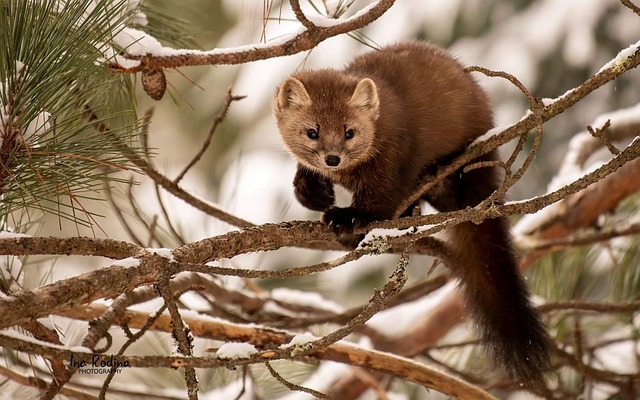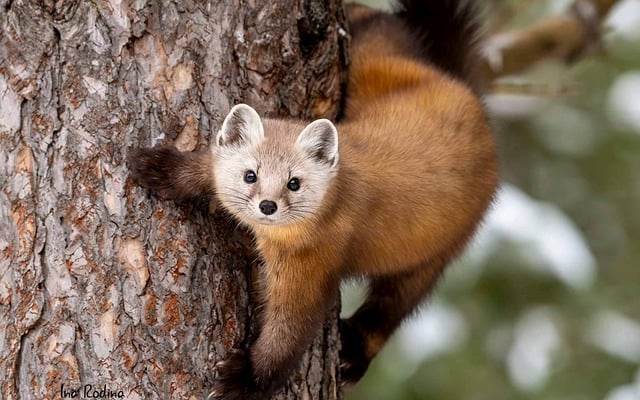The pine marten (Martes martes) is a small carnivorous mammal belonging to the mustelid family, which also includes animals such as weasels, otters, and badgers. It is native to much of Europe and parts of western Asia and is known for its agile climbing abilities and elusive behavior.

Physical Characteristics
The pine marten is roughly the size of a domestic cat, with a slender, elongated body that helps it maneuver through dense forests and trees. Adults typically measure between 45 to 60 centimeters (18 to 24 inches) in body length, with an additional 18 to 25 centimeters (7 to 10 inches) for the bushy tail. They weigh between 0.8 to 2.0 kilograms (1.8 to 4.4 pounds), with males being slightly larger than females.
The animal’s fur is dense and soft, varying in color from chocolate brown to dark chestnut, with a distinct yellow or cream-colored “bib” on its throat and chest. The fur provides excellent insulation during colder months. Its rounded ears are lined with a pale edge, and it has sharp, semi-retractable claws ideal for climbing.
Habitat and Range
Pine martens are most commonly found in temperate and boreal forests, particularly those with a mix of deciduous and coniferous trees. They prefer woodlands with dense canopy cover, which provides ample opportunities for climbing and hunting. Their range spans much of Europe, including the British Isles, Scandinavia, and parts of eastern Europe, extending into western Russia.
Although they are adaptable and can survive in fragmented forests or rocky terrain, habitat destruction has historically impacted their population in some areas.
Diet and Hunting Behavior
Pine martens are omnivorous, but they primarily feed on small mammals such as voles, mice, and squirrels. Their diet also includes birds, insects, eggs, fruits, berries, and carrion. Seasonal availability influences their food choices—for instance, they consume more fruits and berries in autumn.
They are solitary hunters and are most active during dawn and dusk (crepuscular). Their agility allows them to pursue prey both on the ground and in trees, making them effective predators in forest environments.
Behavior and Social Structure
Pine martens are solitary animals, except during the mating season or when a female is raising her kits. They are territorial and mark their range with scent glands and scat, which they often leave on prominent features like rocks or logs to communicate with other martens.
They are highly arboreal, spending much of their time in trees. When on the ground, they move with a distinctive bounding gait. Their dens are typically located in tree hollows, abandoned nests, or rock crevices.
Reproduction and Lifespan
The breeding season occurs during July and August, but due to delayed implantation, the fertilized egg does not implant in the uterus until late winter. This ensures that kits are born during the spring (March to April), when food is more abundant. A female typically gives birth to a litter of 1 to 5 kits, which are blind and helpless at birth. They are weaned by around 8 weeks of age and become independent at 6 months.
Pine martens reach sexual maturity at around 2 to 3 years and can live up to 10 years in the wild, though predation, disease, and habitat loss often reduce their lifespan.
Ecological Role
As both predators and scavengers, pine martens play a vital role in their ecosystems. By controlling rodent populations, they help maintain ecological balance. Additionally, their consumption of fruits and berries aids in seed dispersal.
Interestingly, in areas where pine martens are abundant, they have been observed to suppress invasive grey squirrel populations, indirectly benefiting native red squirrels.
Conservation Status
The International Union for Conservation of Nature (IUCN) lists the pine marten as a species of Least Concern, but local populations face threats due to habitat destruction, hunting, and accidental poisoning. Conservation efforts, such as reforestation and legal protections, have helped stabilize some populations. In the United Kingdom, for instance, pine martens are now protected under the Wildlife and Countryside Act of 1981.
Fun Facts
In Celtic folklore, pine martens were associated with good luck and were sometimes considered sacred animals.
Pine martens are excellent climbers and can leap between tree branches with great precision.
Their playful nature and curiosity have earned them the nickname “tree cats.”

The pine marten is a fascinating and ecologically important species, symbolizing the health and diversity of forest ecosystems. Its adaptability and elusive behavior continue to intrigue wildlife enthusiasts and researchers alike.

